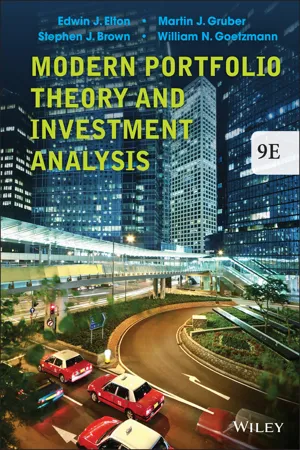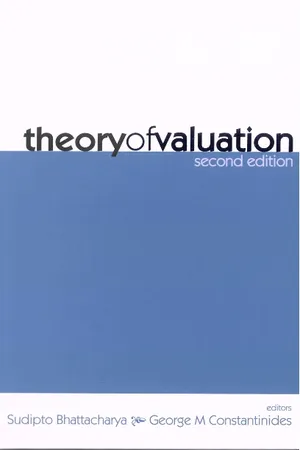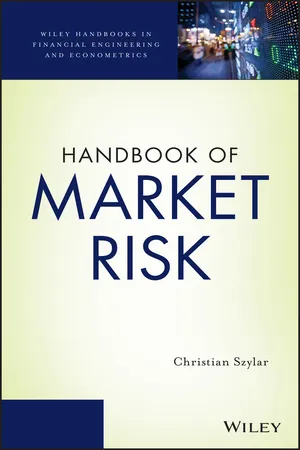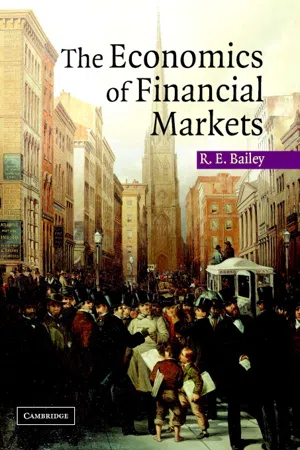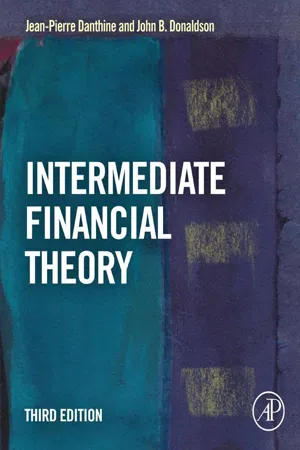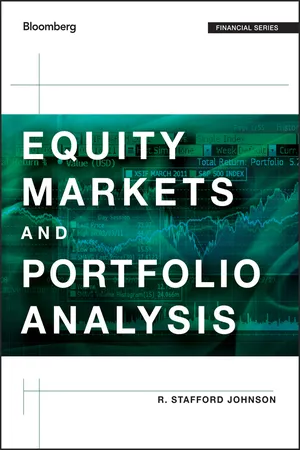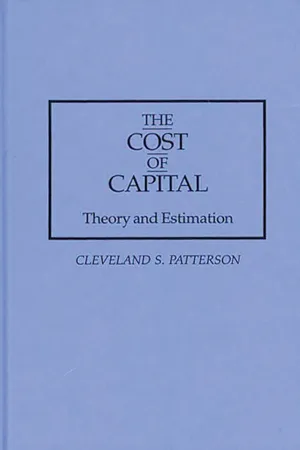Business
Arbitrage Pricing Theory
Arbitrage Pricing Theory (APT) is a financial model used to estimate an asset's expected return based on its risk factors. It suggests that an asset's return is influenced by multiple factors, such as interest rates, inflation, and market risk. APT helps investors understand the relationship between an asset's risk and its potential return, aiding in investment decision-making.
Written by Perlego with AI-assistance
Related key terms
1 of 5
11 Key excerpts on "Arbitrage Pricing Theory"
- eBook - PDF
Investments
Analysis and Management
- Gerald R. Jensen, Charles P. Jones(Authors)
- 2020(Publication Date)
- Wiley(Publisher)
The Law of One Price APT is based on the law of one price , which states that two otherwise identical assets cannot sell at different prices. APT assumes that asset returns are linearly related to a set of indexes, where each index represents a factor that influences the return on an asset. Market participants develop expectations about the sensitivities of assets to the factors. They buy and sell securities so that, given the law of one price, securities affected equally by the same factors will have equal expected returns. This buying and selling is the arbitrage process, which determines the prices of securities. APT states that equilibrium market prices will adjust to eliminate any pure arbi-trage opportunities, which refer to situations where a zero investment portfolio can be constructed that will yield a risk-free profit. According to the theory, if arbitrage opportunities arise, a relatively few investors can act to restore equilibrium. Assumptions of APT Unlike the CAPM, APT does not assume: 1. A single-period investment horizon 2. The absence of taxes 3. Borrowing and lending at RF 4. Investors select portfolios on the basis of expected return and variance APT, like the CAPM, does assume that: 1. Investors have homogeneous beliefs 2. Investors are risk-averse utility maximizers Arbitrage Pricing Theory (APT) An equilibrium theory of expected returns for securities involving few assumptions about inves-tor preferences 8 Richard Roll, “A Critique of the Asset Pricing Theory’s Tests; Part I: On Past and Potential Testability of the Theory,” Journal of Financial Economics , 4 (March 1977): 129–176. 246 Chapter 9 Capital Market Theory and Asset Pricing Models 3. Markets are perfect 4. Returns are generated by a factor model Factor Models A factor model is based on the view that there are underlying risk factors that affect realized and expected security returns. - Edwin J. Elton, Martin J. Gruber, Stephen J. Brown, William N. Goetzmann(Authors)
- 2013(Publication Date)
- Wiley(Publisher)
After discussing some of those alternatives, we present an examination of whether evidence supporting APT is nec- essarily inconsistent with the standard form or any alternative form of the CAPM as a model of equilibrium. We close with a discussion of both applications and advantages of APT. APT—WHAT IS IT? Arbitrage Pricing Theory is a new and different approach to determining asset prices. It is based on the law of one price: two items that are the same cannot sell at different prices. The strong assumptions made about utility theory in deriving the CAPM are not necessary. In fact, the APT description of equilibrium is more general than that provided by a CAPM- type model in that pricing can be affected by influences beyond simply means and variances. An assumption of homogeneous expectations is necessary. The assumption of investors utilizing a mean–variance framework is replaced by an assumption of the process generating security returns. APT requires that the returns on any stock be linearly related to a set of indexes, as shown in Equation (16.1), 1 (16.1) where a i the expected level of return for stock i if all indexes have a value of zero I j the value of the jth index that impacts the return on stock i b ij the sensitivity of stock i’s return to the jth index e i a random error term with mean equal to zero and variance equal to 2 ei For the model to fully describe the process generating security returns, 2 If you are beginning to get the feeling that you have seen all this before, you are right. This representation is nothing more or less than the description of the multi-index model presented in Chapter 8. APT is the description of the expected returns that can be derived when returns are generated by a single- or multi-index model meeting the conditions defined before. The contribution of APT is in demonstrating how (and under what condi- tions) one can go from a multi-index model to a description of equilibrium.- eBook - PDF
- Sudipto Bhattacharya, George Michael Constantinides(Authors)
- 2005(Publication Date)
- World Scientific(Publisher)
discussion Notes on the Arbitrage Pricing Theory Gregory Connor University of California, Berkeley The Arbitrage Pricing Theory (APT) constitutes one of the most important models of security market pricing. The chief aim of Huberman's justly famous paper, reprinted in this volume, is to clarify and simplify Ross's model. He does an admirable job of this. His presentation is so clear that a detailed critical review would be superfluous. I will attempt, instead, a general overview of the APT. A novice to the field might use this broad discussion as a way to solidify his or her understanding of the original papers. An economist familiar with the APT may benefit from seeing another economist's conceptual framework laid out simply. Section I describes a few results from pure Arbitrage Pricing Theory. Pure Arbitrage Pricing Theory is only distantly related to the Arbitrage Pricing Theory. Part of the intent of Section I is to clarify this relationship. The results of this section also have independent interest; Key Result 2 in Section I must be one of the most elegant theorems in financial economics. Section II develops the APT using Ross's original approximate arbitrage argument. Ross conjectured that several assumptions of his model could be weakened, and acknowledged that some of its features could be refined. Section III describes one of the most important refinements: the generalization of the factor model assumption that Ross uses. Section IV develops the competitive equilibrium version of the APT. Section V summarizes the paper and suggests some fruitful directions for future research. Each section (except V) ends with a selective list of references to guide further reading. I. PURE Arbitrage Pricing Theory An arbitrage opportunity is the existence of a collection of assets that can be combined into a costless portfolio with some chance of a positive payoff and no chance of a negative payoff. - eBook - ePub
- Christian Szylar(Author)
- 2013(Publication Date)
- Wiley(Publisher)
Created by Stephen Ross, the APT model is one of the most famous asset valuation models. It is also one of the main competitors of the CAPM model.A key underlying assumption of the APT model is that there is no arbitrage opportunity that lasts in time. Indeed, any asset A being as highly risky as asset B, but with a higher return, would see its demand rapidly increased until its return comes back to the return level of the asset B, therefore canceling any arbitrage opportunity.An arbitrage opportunity is an investment that requires no net outflow of cash and does not carry any chance of loss, but it still has some potential to earn positive return. An arbitrage opportunity arises when two assets offer the same return but trade at different prices: An arbitrageur could buy the cheaper of the two assets and short-sell the more expensive one, earning arbitrage profits. Such arbitrage opportunities do not exist in the equilibrium.APT, originally developed by Ross (1976), attempts to provide a model that explains asset pricing better than the original CAPM. APT is an equilibrium pricing model that that talks about what determines the equilibrium rates of return of capital assets, and it is based on the idea that an asset's returns can be predicted using the relationship between that asset returns and many common risk factors. Arbitrageurs use the APT model to profit by identifying the mispriced securities. A mispriced security will have an actual market price that differs from the theoretical price predicted by the APT model. In other words, the APT model implies that investors will hold infinite positions in an arbitrage opportunity, and this should create pressures on prices to go up where they are too low and fall where they are too high, so in equilibrium the market should satisfy the no-arbitrage condition. The absence of arbitrage implies the “law of one price”: Two assets with identical investment characteristics must trade at the same price. No arbitrage opportunities exist among well-diversified portfolios - eBook - PDF
- Roy E. Bailey(Author)
- 2005(Publication Date)
- Cambridge University Press(Publisher)
8.4 Summary On its own, the arbitrage principle, being founded on so few assumptions, provides few testable predictions about asset prices. The principle is made empirically relevant when applied to a model of asset prices. This chapter analyses one such application, the Arbitrage Pricing Theory. The APT comprises two components. 6 P and Q are ‘factor-specific’ portfolios, chosen such that their rates of return respond only to factors 1 and 2, respectively; and respond with unit coefficients b P 1 = 1, b Q 2 = 1. Factor models and the Arbitrage Pricing Theory 195 1. Factor models . These postulate that each asset’s rate of return is a linear function of a small number of factors. The models do not themselves involve arbitrage at all. Instead, factor models provide a framework in which the arbitrage principle can be invoked. 2. Application of the arbitrage principle. The absence of arbitrage opportunities in the context of a factor model implies a set of restrictions on observable asset prices (or, equivalently, on expected rates of return). In particular, the APT predictions enable a risk premium to be associated with each of the factors. The risk premia differ across factors but are equal across assets. It is this implication that gives predictive force to the APT in empirical applications. Also: (a) a special case, useful in applied studies, corresponds to factor models in which the factors are themselves rates of return on portfolios of assets; and (b) the APT and CAPM are not incompatible with one another, though the APT is consistent with a broader range of empirical evidence – and consequently is more difficult to reject in econometric studies. Further reading All modern finance texts offer expositions of factor models and the APT, though the fundamental requirements for, and implications of, the arbitrage principle often receive only scant attention. - eBook - ePub
- Jean-Pierre Danthine, John B. Donaldson(Authors)
- 2014(Publication Date)
- Academic Press(Publisher)
Chapter 14The Arbitrage Pricing Theory
Chapter 14 introduces the concept of a factor model of security return determination, and the attendant Arbitrage Pricing Theory. The chapter has an applied orientation with special emphasis on the construction of factor mimicking portfolios.Keywords
Arbitrage Pricing Theory; market model; pure factor portfolio; momentum factor; SMB factor; HML factorChapter Outline14.1 Introduction 41714.2 Factor Models: A First Illustration 41914.2.1 Using the Market Model 42014.3 A Second Illustration: Multifactor Models, and the CAPM 42114.4 The APT: A Formal Statement 42414.5 Macroeconomic Factor Models 42614.6 Models with Factor-Mimicking Portfolios 42814.6.1 The Size and Value Factors of Fama and French (1993) 42814.6.2 Momentum Portfolios 43414.7 Advantage of the APT for Stock or Portfolio Selection 43614.8 Conclusions 437References 437Appendix A.14.1: A Graphical Interpretation of the APT 438Statement and Proof of the APT 439The CAPM and the APT 441Appendix 14.2: Capital Budgeting 44114.1 Introduction
We have already made two attempts (Chapters 11 –13 ) at asset pricing from an arbitrage perspective, i.e., without specifying a complete equilibrium structure. Here we try again from a different, more empirical angle. Before doing so, let us first collect a few thoughts as to the differences between an arbitrage approach and equilibrium modeling.In the context of general equilibrium theory, we make hypotheses about agents—consumers, producers, investors; in particular, we start with some form of rationality hypothesis leading to the specification of maximization problems under constraints. We also make hypotheses about markets: typically, we assume that supply equals demand in all markets under consideration, and that the markets are competitive. - eBook - ePub
- R. Stafford Johnson(Author)
- 2014(Publication Date)
- Bloomberg Press(Publisher)
CHAPTER 10 The Arbitrage Pricing TheoryIntroduction
The CAPM is based on a single-index model in which all security returns depend only on the market return. In Chapter 8, we examined this model, as well as the multi-index model in which all security returns are assumed to be a function of more than one factor. Just as the CAPM can be viewed as an extension of the single-index model, the Arbitrage Pricing Theory (APT) can be viewed as an extension of the multi-index model. In fact, the contribution of the APT to the finance literature is in showing how an equilibrium model can be extended from one determining factor to multiple factors. The APT also differs from the CAPM in that it is more general. That is, it is based on fewer assumptions than the CAPM, and unlike the CAPM, which considers systematic risk as the determining factor, APT does not specify what factors determine a security's equilibrium returns, leaving this to empirical inquiry. What APT does do is delineate how arbitrage determines equilibrium returns. In this chapter, we examine APT.Derivation of the Model
In Chapter 9, the SML was derived by demonstrating that in the absence of arbitrage all securities must be on a line in return and beta space. The APT applies this same arbitrage argument to establish the equilibrium state for cases in which investment returns are determined by a number of factors. The model starts by assuming that the returns on any security or portfolio are linearly related to a common set of factors (Fj ). That is:Such factors could be the market return, an industry return, aggregate output, inflation, or the difference between long-term and short-term bond rates. As we noted above, the model does not specify the factors, it only requires that there be a common set of factors determining investment returns. The APT model also assumes that the standard regression assumptions hold (E(ϵi ) = 0; V(ϵi ) is constant over observations; cov(ϵi Fj ) = 0), and that there is no correlation between the error terms for different securities and portfolios and no correlation between factors: cov(Fj Fk - eBook - PDF
The Cost of Capital
Theory and Estimation
- Cleveland S. Patterson(Author)
- 1995(Publication Date)
- Praeger(Publisher)
Arbitrage Pricing and Other Models 159 tions and on the distribution of asset returns. As discussed by Lehman and Modest (1988), the level of the intercept term depends on which exact pricing model is speci- fied. Alternatively, Wei (1988) showed that one need only add the return on the market portfolio as an extra factor to obtain an exact pricing relationship. 2. If asset returns are believed by investors to be generated by their relationship to returns on a well-diversified observable market index, R* m , such as the NYSE index, then the no-arbitrage conditions of the APT can be used to derive a security market line that is identical in form to the CAPM without the restrictive assumptions of the CAPM and without reference to the unobservable global market portfolio. Unfortunately, the price of this more general derivation o^ the CAPM relationship is that the APT approach does not guarantee the relationship for all securities at all times, as discussed in the previous note. Nevertheless, it provides some assurance that the CAPM is likely to be at least approximately valid as long as investors are able to diversify away non- systematic risks. 3. There is an important difference between the critical assumption underlying the APT and that underlying the CAPM. The CAPM is based on a dominance argument, which rests on the assertion that if the equilibrium risk-return relationship is violated, many investors will make small adjustments to their portfolios in response. Equilibrium prices will be restored if there is a sufficient number of investors who behave in this way to dominate the pricing process. In the APT framework, however, when risk-free zero-investment arbitrage opportunities exist, every investor will wish to take as large a position as possible so that only a very few are required to force restoration of equi- librium pricing. - eBook - PDF
Asset Pricing
Revised Edition
- John H. Cochrane(Author)
- 2009(Publication Date)
- Princeton University Press(Publisher)
It is crucial that the extra factors affect the average investor. If an event makes investor A worse off and investor B better off, then investor A buys assets that do well when the event happens, and investor B sells them. They transfer the risk of the event, but the price or expected return of the asset is unaffected. For a factor to affect prices or expected returns, the average investor must be affected by it. We should expect many factors, common movements in returns, that do not carry risk prices. Industry portfolios seem to be an example; industries move together but average returns do not vary by industry once you control for other betas. As you can see, this traditional intuition is encompassed by consump-tion, or marginal utility more generally. Bad labor market outcomes or bad news about future returns are bad news that raise the marginal utility of wealth, which equals the marginal utility of consumption. The promise of the consumption-based model was that it would give us a single indi-cator that captures all of these general-equilibrium determinants. It still does, theoretically, but not (yet) in empirical practice. 9.4. Arbitrage Pricing Theory (APT) 173 9.4 Arbitrage Pricing Theory (APT) The APT: If a set of asset returns are generated by a linear factor model, R i = E ( R i ) + N j = 1 β ij ˜ f j + ε i , E (ε i ) = E (ε i ˜ f j ) = 0. Then (with additional assumptions) there is a discount factor m linear in the factors m = a + b f that prices the returns. The APT, developed by Ross (1976a), starts from a statistical characteri-zation. There is a big common component to stock returns: when the market goes up, most individual stocks also go up. Beyond the market, groups of stocks move together, such as computer stocks, utilities, small stocks, value stocks, and so forth. Finally, each stock’s return has some completely idiosyn-cratic movement. This is a characterization of realized returns, outcomes , or payoffs . - eBook - PDF
- Noel Amenc, Veronique Le Sourd(Authors)
- 2005(Publication Date)
- Wiley(Publisher)
In this chapter we begin by presenting multi-factor models from a theoretical point of view, and then describe the methods for choosing the factors and estimating the model parame- ters. Finally, we present the two main applications of these models, namely risk analysis and evaluation of portfolio performance. 6.1 PRESENTATION OF THE MULTI-FACTOR MODELS The earliest model, which comes from Ross, is based on a key concept in financial theory: arbitrage valuation. A second category of models, based only on empirical considerations, was developed later. This section presents the structure of these two types of model. 6.1.1 Arbitrage models In 1976, Ross proposed a model based on the principle of valuing assets through arbitrage theory (see also Roll and Ross, 1980). This model, called the Arbitrage Pricing Theory (APT) model, is based on less restrictive assumptions than the CAPM. While the CAPM assumes that asset returns are normally distributed, the APT does not hypothesise on the nature of the distribution. The APT model does not include any assumptions on individuals’ utility functions either, but simply assumes that individuals are risk averse. This simplification of the assumptions allows the model to be validated empirically. 1 For more details, the interested reader could consult Batteau and Lasgouttes (1997), Fedrigo et al. (1996), Marsh and Pfleiderer (1997), Chapters 8 and 16 of Elton and Gruber (1995), Chapter 4 of Farrell (1997) and Fontaine (1987). 150 Portfolio Theory and Performance Analysis The APT model still seeks to explain asset returns through common factors, but instead of the well-defined single factor in the CAPM, the model employs K factors and consequently constitutes a more general theory. The problem then consists of determining the value of K and the nature of the factors. That will be the subject of Section 6.2 of this chapter. The present section simply describes the theory underlying the model. - James A. Primbs(Author)
- 2016(Publication Date)
- Chapman and Hall/CRC(Publisher)
4.3.2 Profit/Loss and Arbitrage In this case, the profit/loss on the portfolio is given by the sum of the product of the number of units of each asset held, y , with the profit/loss from holding each unit d V , y T ( d V ) = y T ( A dt + B dz ) = ( y T A ) dt + ( y T B ) dz. (4.31) Therefore, an arbitrage portfolio can be defined as follows. ( ⋆ ) An Arbitrage Portfolio An arbitrage portfolio is a specification of the number of units held of each asset y ∈ R n that satisfies the three equations y T P = 0 No cost. y T B = 0 No risk. y T A > 0 Profit. Of course, we want to eliminate arbitrages, so we would like the following implica-tion to hold, which once again is not in a form that is terribly useful. ( ⋆ ) A (not very useful) Necessary Absence of Arbitrage Condition If there is no arbitrage, then the following implication must be true, y T P = 0 No cost y T B = 0 No risk bracerightbigg ⇒ y T A = 0 No profit/loss , (4.32) which can be written in matrix form as bracketleftbigg P T B T bracketrightbigg y = 0 ⇒ A T y = 0 . As in the case of returns, we can convert this to a dual condition that is useful. ( ⋆⋆ ) Price APT: A Useful Necessary Absence of Arbitrage Condition A necessary condition for no arbitrage is for there to exist a ˆ λ ∈ R m +1 such that A = bracketleftbig P B bracketrightbig ˆ λ = P λ 0 + B λ (4.33) where ˆ λ = bracketleftbigg λ 0 λ bracketrightbigg with λ 0 ∈ R and λ ∈ R m . We refer to the above result, and equation (4.33) in particular, as the Price APT . 56 squaresolid A FACTOR MODEL APPROACH TO DERIVATIVE PRICING What is the relationship between the Return APT and the Price APT? Of course, they are basically equivalent. The λ ’s in both cases are the same, and have the same interpretation. They are market prices of risk. The main difference is that the price approach uses shares or units of the asset to describe the portfolio, not dollar amounts.
Index pages curate the most relevant extracts from our library of academic textbooks. They’ve been created using an in-house natural language model (NLM), each adding context and meaning to key research topics.

